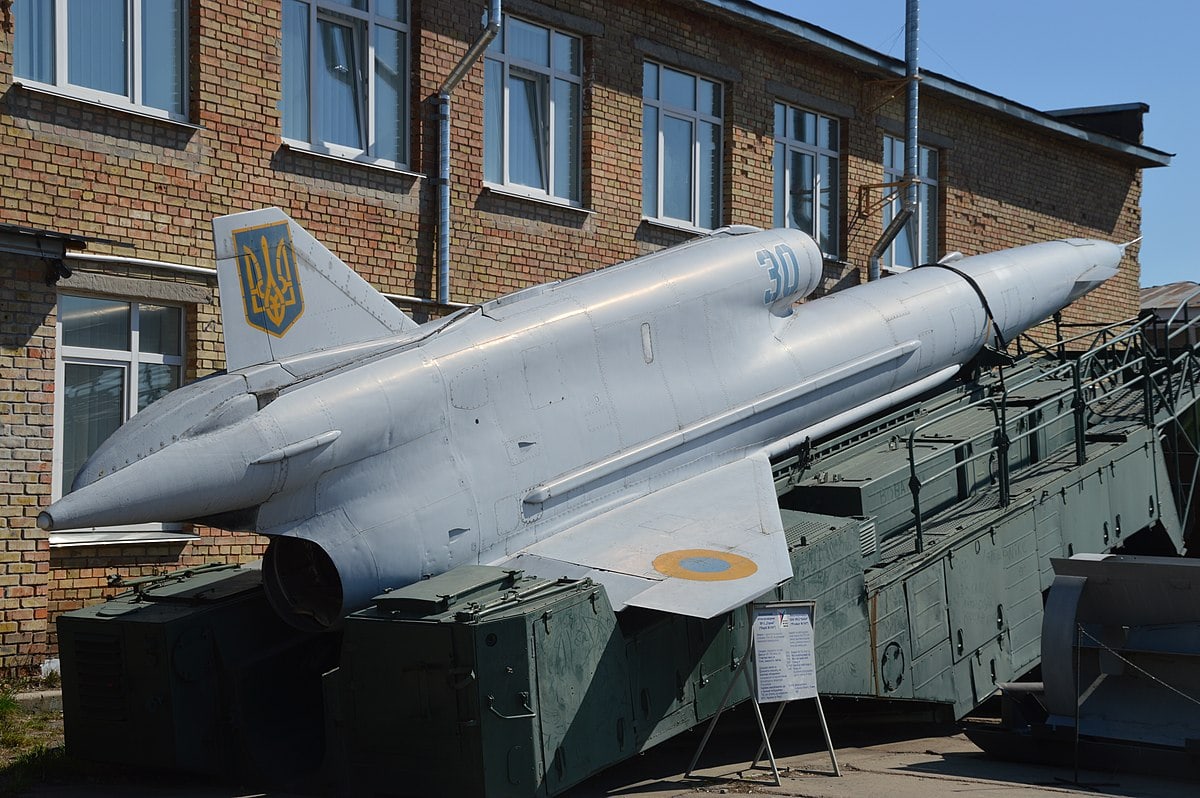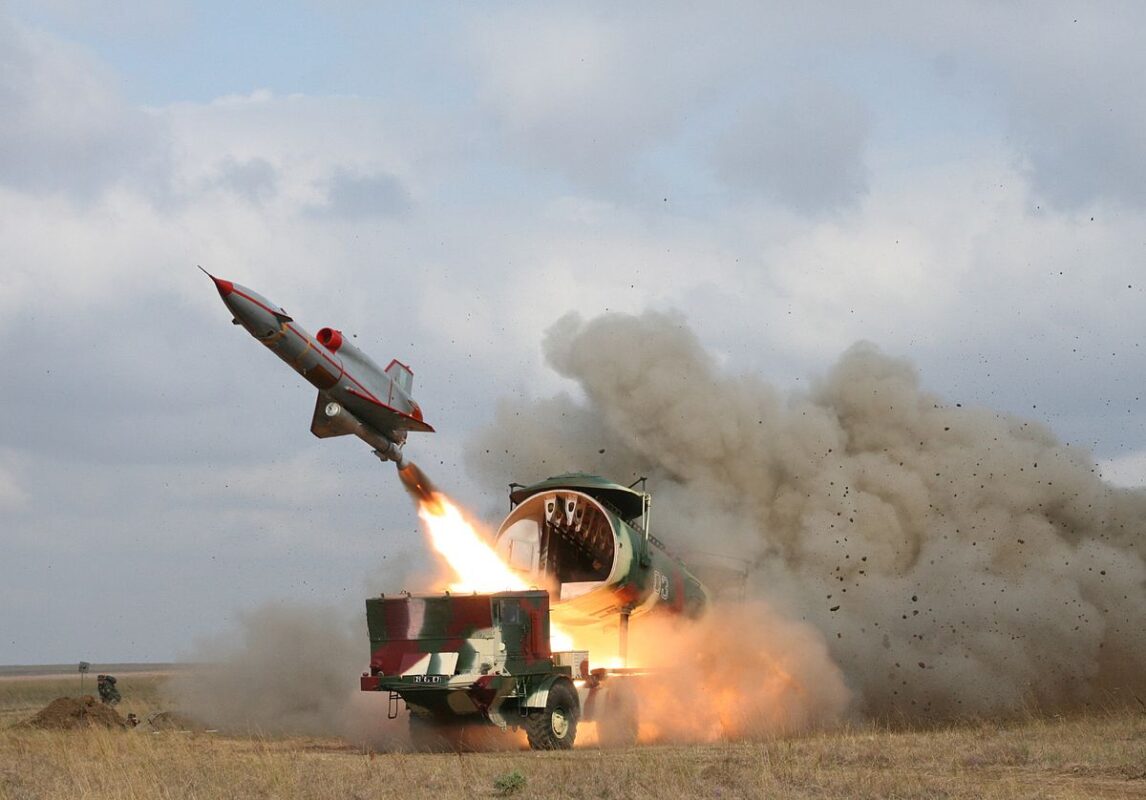Sebastien Roblin

It was business as usual early on Dec. 5 at Diaghilevo, a Russian bomber base situated 100 miles southeast of Moscow. Though primarily used by training units, pilots and ground crew were in the process of refueling a Tu-22M3 Blackfire supersonic bomber on the flight line, with at least one huge Kh-22 anti-ship cruise missile newly loaded underwing.
Later that day several would take off and launch the supersonic weapons not at the U.S. Navy warships they were designed to destroy, but rather at the electrical and gas heating infrastructure of Ukraine, 280 miles away.
Unlike the strategic bombers that rained gravity bombs on cities in the World Wars, Korea and Vietnam, in 2022 Russia’s bombers delivered their missiles well outside Ukrainian airspace, beyond the reach of even Ukraine’s long-range S-300 air defense batteries, and thoroughly insulated against Ukrainian fighters under their own air defense umbrella.
But at 6 AM, a jet-powered drone plummeted down into a refueling truck. The resulting conflagration shredded the rear fuselage and wings of the Backfire bomber and killed two ground crew and a bomber pilot with the rank of major. The bomber, RF-4110 (Red 02), was almost certainly put out of service for the foreseeable future.
At roughly the same time, another drone kamikazed into the flight line at Engels-2 airbase near Saratov, 400 miles from Ukraine. This was the home base of the 22nd Heavy Bomber Division’s huge Tu-160 Blackjack jet bombers and venerable Tu-95MS Bear turbo-prop bombers routinely pumping Kh-555/Kh-101 land-attack cruise missiles into Ukraine.
This drone attack wounded two and damaged at least one, possibly two of the nuclear-capable bombers. Security camera recordings show the loud blast set off car alarms up to four miles away. Subsequently, satellite photos showed scorched tarmac and one of the Bears washed over with firefighting foam, though the seriousness of the damage remained unclear.
Despite the strikes, eight Tu-95s took to their air later that day and launched 38 subsonic cruise missiles at targets in Ukraine, with another three Kh-22s contributed by Tu-22M3 jets, according to Ukraine’s air force.
The Ukrainian drone strikes weren’t over yet, though. While a kamikaze drone was downed near Kursk on Dec. 5, the following day another slammed into a fuel reservoir at Khalino airbase, starting a blaze. Russian sources alleged a fourth drone was downed attempting an attack on Belbek airbase on the Crimean peninsula.
Russian reports described the attacking munitions as Soviet jet-powered drones, an unambiguous reference to the turbojet-powered Tupolev Tu-141 and Tu-143 reconnaissance drones Ukraine had used in attacks earlier in the war, mostly without clear success.
Soviet recon drone makes mid-life career change
Strictly speaking, there still isn’t visual confirmation that Ukraine used Tu-141s for the strike, modified or otherwise. Prior to the attacks, Ukrainian officials had claimed they were readying a new long-distance kamikaze drone with a strike range of 620 miles and a 165-pound warhead. It’s possible that the new drone may in effect be a modified variant of the Tu-141, although it could also refer to an entirely new platform.
Nonetheless, most analysts believe the strikes were carried out by Tu-141s in some form, so let’s take a closer look at how 40-year-old drones may have been refashioned into cruise missiles.
Entering service in 1979, the Tu-141 Strizh (Swallow), or VR-2, was built to perform quick round-trip reconnaissance runs up to 620 miles deep into hostile airspace, using either old-school film cameras or alternate payloads such as infrared or radar imagers. Pre-programmed with navigational instructions prior to launch, the 14-meter-long Swallow was launched from a truck-towed trailer using discardable rocket boosters.

Typically skimming at low altitude, the Tu-141 could hit transonic speeds of 620 to 680 mph (ie. just below the speed of sound) thanks to its dorsally mounted KR-17 turbojet engine. Upon returning to base, it would release a parachute in its tail and float down to the earth, whereupon its recorded camera footage could be physically recovered for processing.

The Kharkiv Aviation Plant in Ukraine built a total of 152 Tu-141s. In 1982, these were joined by 950 slower and much smaller but similar-looking Tu-143 Reys (“Flight” or “Voyage”) or VR-3 drones with range reduced to just 125 miles for tactical reconnaissance missions. The eight-meter long Tu-143 could carry similar payloads to the Tu-141, as well as an electromagnetic sensor and potentially a datalink to transmit findings back to base.

Ukraine ended up inheriting the lion’s share of the drones: a regiment each of Tu-143s and Tu-141s, as well as three independent Tu-141 squadrons. The Tu-143 was also extensively exported, with many since retired from service in central European states, and others still operational in Belarus, North Korea, Russia and Syria.
Ukraine’s gradually downsized drone force would primarily end up serving for air defense target practice but for Russia’s invasions in 2014. The Tu-141s and Tu-143s in the last remaining 383rd Remote-Control Aircraft Regiment were thus refurbished and deployed to perform photo-reconnaissance missions over areas held by Russian forces which had already downed several Ukrainian military assets. Two Tu-143s were lost in, one due to a malfunction and another lost over Luhansk possibly due to enemy fire.
At the onset of Russia’s 2022 invasion it became clear Ukraine had sought to weaponize the drones. On March 10, an errant Tu-141 soared over Romanian and Hungarian airspace, detected too late for NATO fighters to intercept it, and smashed close to a university dormitory in Zagreb, Croatia with a fortunately undetonated OFAB-100-120 220-pound bomb attached.
Later in March and April, several Tu-141s and Tu-143s were shot down well into Russian airspace, including three near Kursk, one near Rostov, and another near Bryansk. Counting additional Tupolev drones downed over Ukrainian soil, Russia has reported downing 5 Tu-141s and 6 Tu-143s.
It’s not clear whether any of the Tu-141/143 strikes were successful, particularly as Kyiv wouldn’t report those on Russian soil due to their politically sensitive nature. Admittedly, several attacks using unspecified means proved very destructive, and could have been the work of Tupolev drones. However, it seems likely these drones, reliant on gyroscope-based inertial navigation systems, were insufficiently precise to be very effective,
The obvious method to improve precisions would involve integrating satellite navigation using GPS or Russia’s GLONASS constellations, which were in their infancy when the Tupolev drones entered service. As the exact locations of parked Russian bombers can be seen in commercial satellite imagery, Ukraine could instruct the drones to crash into their habitual coordinates.
A more challenging method would be to remotely pilot the cruise missile into target. This would require a command /communication link transmitting a real-time video feed from the perspective of the drone. This is problematic, as the targeted bases lie beyond the range of line-of-sight communication links in Ukraine. However, an official interviewed by the New York Times claims that in one instance a Ukrainian agent “close to the base…helped guide the drones to the target.” Perhaps a forward-deployed agent could assume remote control of the drone once it had approached within range.
Ultimately, neither attack achieved direct hits. But the fact the subsonic drones broke through Russia’s air defense system should worry Moscow. Likely, by flowing at low altitude the drone-missile masked itself against long-range area air defense radars; while perhaps short-range defenses simply weren’t positioned to detect and down an attack which had a priori been thought impossible.
Such vulnerability remains shocking given that Engels-2 is a base for nuclear-armed bombers which one would expect to be prepared for attacks by surface-skimming cruise missiles. Also troubling for Russia’s military is that a drone that can fly from Ukraine to Diaghilevo could also likely hit targets in Moscow.
It’s unclear how many more weaponized Tu-141s (or alternative systems) Ukraine has at hand, given the known losses and relatively limited number built. Ukraine is likely quietly continuing development of long-distance kamikaze drones, the Korshun-2 cruise missile and the Grom-2/Sapsan ballistic missile system that it began before Russia’s invasion. Kyiv’s allies are so far unwilling to provide such long-distance weaponry, fearing it could lead to dangerous escalation from Putin.
For Ukrainian civilians under daily bombardment the Dec. 5 strikes were a symbolically satisfying ‘Doolittle Raid moment’ even if insufficient by themselves to heavily dent Russia’s bomber campaign. Russia’s military, in turn, will be compelled to commit resources to and prepare psychologically to defend even distant airbases against a threat that it didn’t believe existed before
No comments:
Post a Comment